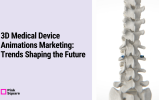Engineers. Who are they? What do they eat? Where do they hide? What marketing strategies do they respond to?
As a marketer, you want to make sure to speak to your audience in their own language. When writing to engineers, you need to be aware of the Marketing trends that promise to affect their industry. In this post, we will explore the answer to the last question: what marketing strategies are engineers more likely to respond to.
Based on what worked well in previous year and on what we observed in the first month of this year, we are betting our chips on these three tendencies:
- Inbound marketing completely replacing outbound
- Heavy use of visual content on different platforms
- Introduction of 3D animations to demonstrate products
While the use of inbound marketing and visual content probably come as no surprise to the attentive marketer, 3D animations are just starting to make their way into product marketing.
We will walk you through each of the three trends, explaining what they are all about and why we think you should make use of them when marketing to engineers and other technical audiences.
1. Inbound marketing completely replacing outbound
In recent years, there has been a gradual change in the way people are moved to buy products. While before the idea was to advertise for the masses and hunt customers down, today there is much more focus on personalized communication and letting the customer come to you when they’re ready.
In 2018 marketers in Europe will have an even stronger reason to go inbound, namely the new General Data Protection Regulation (GDPR), which makes it illegal to purchase email addresses and send messages out to people without their consent. This means that we will be seeing a rapid shift from outbound to inbound, with strong focus on providing value and earning users’ trust.
Let’s take a look at some basic premises of inbound marketing, what makes it so effective and how it can make a difference when targeting engineers.
What is inbound marketing?
Inbound marketing is a methodology that puts the focus on the consumer. Instead of saying: “Buy my product! I make the best X in the world”, inbound marketers want to offer something of value without expecting an immediate purchase. The Hubspot emphasizes the importance of offering value:

In order to attract these qualified prospects (and not just random people), you need to be present at the right place, i.e., where your leads are. That means social media, blogs, events, webinars, etc. This strategy is in direct contrast to traditional marketing, in which companies attempt to find customers and almost force them to consume their products.
While the “attraction stage” is the most critical, it is certainly not the only stage that differs from outbound marketing. With inbound, you build awareness of your brand by nurturing leads and shifting your focus to the consumer. As a rule of thumb, you should continue to provide valuable content once you’ve converted visitors into leads and even after you close the deal.
Why you should invest in inbound marketing instead of outbound
As consumers, we encounter advertisements across every communication platform we use. Consequently, we’ve grown more discerning about which messages we allow to penetrate our filters. From a marketer’s viewpoint, it’s important to recognize that our target audience isn’t a faceless mass with wallets, but rather fellow consumers who, like us, are weary of irrelevant commercial messages.
Let me give you a simple example. Imagine you are having dinner and suddenly you get a call from an unknown number. What is your first reaction?
- “Oh that must be a telemarketing call! I’d better stop eating and really pay attention to this person who wants to sell me something.” Or
- Oh no, telemarketing! Don’t these people have any respect for my privacy? I don’t care what they are trying to sell, this is just not a good time.”
Time is precious and no one wants to interrupt what they’re doing to listen to a stranger talk about something they don’t need. People are tired of banners, outdoors, tv commercials and all those traditional marketing strategies that interrupt the natural flow of their day.
That’s why you want to reach them when they have their guards down. For instance, if your company sells coffee, you could write a tutorial explaining how to make great tasting coffee. That way, when someone searches for “how to make coffee”, they will see your content and respect you as an authority. By offering guidance to your prospects, you start to build a relationship with them, and that makes them much more likely to come to you when they want to buy coffee again.
Why is inbound marketing appealing to engineers?
Right now you must be thinking “they’re going on about coffee here, but what I really want to know is how this is going to help me market my product to an audience of engineers.” Well, engineers may have a technical job, but at the end of the day, they respond to many of the same strategies that work in B2C marketing.
A study ran by Trew Marketing and Engineering.com found that 87% of engineers rely on search engines as the most valuable source of information for their jobs. This means that marketers have a fantastic opportunity to make their content available online for this kind of audience. If you can provide useful information instead of just shouting out your brand name, chances are that you will convert this lead into a customer.
Data from the same study points out that engineers prefer long-form content such as case studies, application notes, white papers and e-books. We can conclude that this audience favors in-depth content over short articles. Content marketers should welcome these results, since it shows that engineers are open to quality written content.
The preference for written content among engineers is closely followed by visual content. Research indicates that this tendency will continue strong, so let’s take a closer look at the use of visuals for technical audiences.
2. Heavy use of visual content on different platforms

In 2017, European engineers have pointed at visual content as their second go-to source of information for their jobs (We talked about the number one choice in the previous section). The main types of visuals mentioned were product demos/ how to videos, infographics/ diagrams and other images.
To be more specific, 89% of respondents considered product demonstration videos to be either somewhat or very valuable. Still images and infographics are just slightly less appreciated, with over 80% of engineers rating them as valuable. These numbers are much higher in comparison to other forms of content cited, such as surveys, reports and blog articles.
Based on last year’s analysis, we can safely assume that this will be another good year for visual content. Here are three reasons to use visuals when marketing to engineers.
Save time without compromising quality
We’ve discovered that engineers prefer to delve deep when seeking information online. In fact, nearly 40% of them will meticulously go through the first 10 pages of search results. This indicates that superficial content won’t capture their attention. The key is to provide substantial value while ensuring that your audience can quickly grasp the essence of your message.
What better way to do that than using an image or a video? Research shows that the human brain processes visuals 60,000 times faster than text! That means that you can communicate a wealth of information through an infographic or a video without taking up hours of your viewers’ time. While written content undeniably has a prominent role in marketing communication, visuals are essential as a complement or stand-alone message.
It is a well-known fact that our attention span is less than admirable. In 2015, the Telegraph reported the results of a study comparing a humans’ attention span to that of a goldfish. That gives you approximately 8 seconds to grab your viewer’s attention and put your point across before they get sidetracked. It is definitely a challenge, but one that can be made easier with the use of visuals.
Help your audience remember the information they see
Think about a book you read that was later turned into a movie. When you eventually watched the movie, did you go: “oh, I did not remember that”? We’ve all had this experience at some point and there is a simple explanation to it. Our brains are wired in a way that retains visual stimuli at a much higher rate than written words. So chances are that you’ll remember something much more easily if you see an image of it than if you get the same information in writing.

Visual content makes up an astounding 90% of all the information the brain absorbs. The reason why this happens is that it takes more brainpower to process a visual information than pure text. And the more active the brain is in assimilating information, the more likely it is to retain in. From a marketing perspective, it is essential to keep this in mind when preparing any sort of material for your campaigns. After all, you want people to remember your message.
Increase social sharing
Statistically, visual content is the type most likely to be shared on social media. Data from Buffer shows that tweets with images are retweeted up to 150% more. Similarly, posting an image on your facebook page will make your content 70% more likely to be shared than if you use plain text.

What’s great about visuals is that there is so much variety of formats. Visual content includes anything from the images you use in the body of an article, to explainer videos, memes, infographics and anything in between. To increase engagement with your brand, use as many different formats as possible. And let’s not forget that there are countless platforms where you can make your content available to your audience, such as youtube, vimeo, pinterest, etc. Here is a great article to help you decide what platforms are best for your company’s content.
But as with the written content, it is important to make sure that every visual associated with your company meets the quality standards. You don’t want to be remembered as “the company with the useless graphs” or anything like that. Another issue to consider is frequency. There is no point in uploading a video to your social media accounts every single day just to get people’s attention. It has to add value to your followers and make sense within your overall strategy.
When marketing technical products, one type of visual communication in particular can prove to be a great asset. That leads us to the third trend.
3. Introduction of 3D animations to demonstrate products
We’ve all seen videos with 3D characters guiding us through a sequence of events or explaining how a service works, such as this one from Walmart. Explainer videos like this have become popular in the past couple of years and are a great way to show the benefits of your product or service.
The hot news for 2018 is the possibility to use 3D animations to demonstrate products. This kind of animations are perfect to reach a technical audience since they allow for a 360° view of the product. Check out three features that make 3D animations optimal for engineering marketers.
A simple way to display complex products.
Most of the products we use in our daily lives are straightforward and easy to understand. Everyone knows how to open a closet door or how to use a remote control. But engineers often deal with products that are complex and require a lot of explaining to somebody who is not involved in the same industry. For example, it could be a conveyor belt, a system of drainpipes or any kind of machinery that is not part of the average person’s life.
A 3D animation makes it much easier to demonstrate a product, whether it is something that requires assembling, such as an engine, or a consumer good that can be opened and closed such as a sofa bed or an extendable table for example. The reason why it is so easy is that an animation can show products from every angle, meaning that you can spin it around at 360° or even peek inside of it, just like you would do if you were holding it in your hands.

One could say that a 3D animation allows you to reach a higher level of understanding than if you were physically demonstrating the product. This is especially true for large equipment or machinery when there is a need to show their inner working. Let’s say you want to demonstrate how a boiler works. With an animation, you can “cut out” the front and easily show the water flow inside. In the “real world”, it wouldn’t be possible to keep the system working if you removed half of it.
Faster than traditional video
How long we are willing to dedicate our attention to a video depends on which platform we are using. We spend the least amount of time on Instagram and Twitter, a little bit longer on Facebook and around 2 minutes on YouTube. But 2 minutes is not a lot of time (unless you’re waiting for someone to reply to your text or holding a plank at the gym). It might be long enough for the images that show how a product works, but you can’t have the audio going too fast, or you’ll lose your audience.
3D animations can demonstrate a product faster than a video with human actors. For instance, if you have a wall mount that requires eight screws, an animation can show all eight of them going into the wall at the same time. To show a person driving the screws one by one would take much longer, even if you fast-forwarded the action. Not only are animations faster, they also make the scene clearer, since you don’t have to deal with a person’s hands blocking the view while they’re working on the product.
If you put a 3D animation and a recording of the same action side by side, you will see that 3D accomplishes the task 5 times faster. That is possible because animated parts can move themselves into place in a way that is self-explanatory. While it is true that you can do a lot with traditional demo videos, 3D animations take your demonstration one step further, by making the process clearer and faster.
Affordable for large and small companies alike
Large multinational brands are already making use of 3D animations, as you might have seen in the iPhone 8 campaign. But you don’t need to have Apple’s turnover to get a 3D animation. As the industry becomes more and more advanced, their cost of production also decreases. To say that animations are not doable for small and medium sized companies is at the very least a misconception. Animations will be even more popular than in previous years, which also helps to bring their price down.
It used to be expensive to purchase a 3D animation, which is why this service was more or less exclusive of large enterprises. Nowadays, there are companies who make it affordable for small and medium businesses to join in on the fun. The investment will quickly pay for itself and you’ll have a professional, foolproof way of showcasing your product. The best part is that you don’t need to know anything about 3D animations in order to purchase one. Just explain what you need and let the pros take it from there.
So there you have it. Inbound marketing, visual content and 3D animations are the top three trends for engineering marketers in 2018. Are you already using these strategies? Click the buttons below and let us know in the comments.









